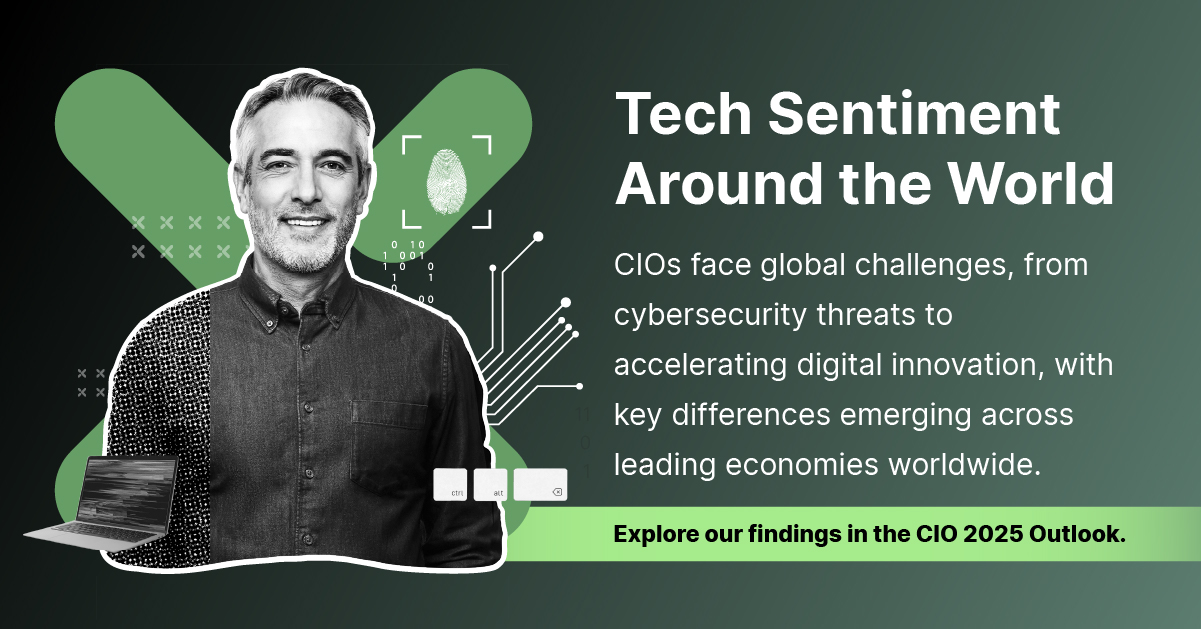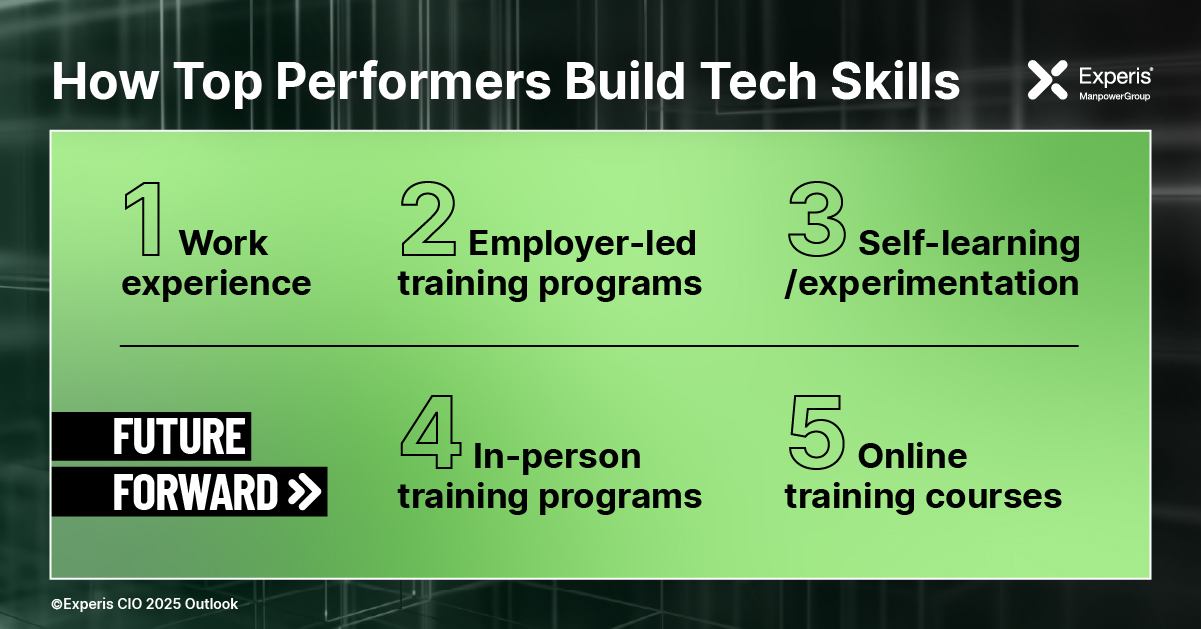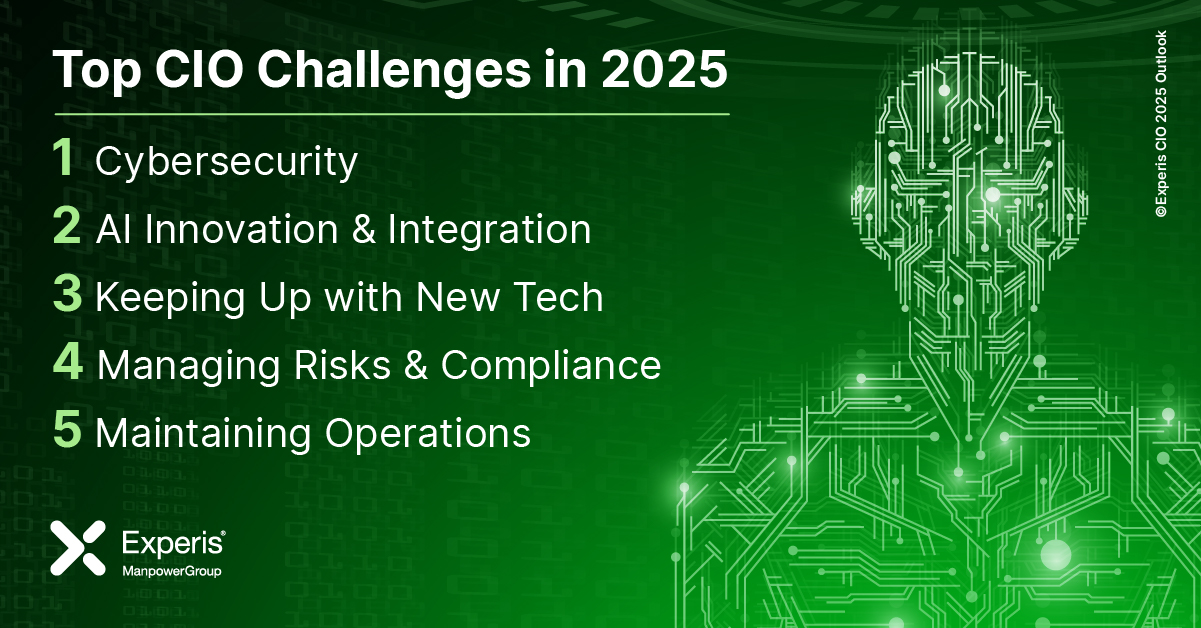In today's rapidly evolving digital landscape, Chief Information Officers (CIOs) find themselves walking a precarious tightrope. On one side looms the ever-present specter of cybersecurity threats; on the other, the pressing demand to drive innovation and digital transformation. How are today’s technology leaders managing this delicate balance?
Our new Future Forward: CIO 2025 Outlook research provides compelling insights into this question. Drawing from an extensive study of 1,393 technology leaders—including 480 C-suite executives and 913 senior IT decision-makers across nine countries—we've uncovered a portrait of the modern CIO’s challenges, priorities, and strategic approaches.

Key Findings: The Security-Innovation Paradox
The data tells a fascinating story of how technology leaders are responding to competing priorities:
41% of CIOs report cybersecurity as their top concern that "keeps them up at night."
77% are increasing security budgets, 68% are expanding cloud infrastructure, and 67% are accelerating AI capabilities.
This isn't a contradiction—it’s a strategic necessity. Today’s most successful technology leaders aren’t making tradeoffs between security and innovation; they’re developing integrated approaches where robust cybersecurity enables, rather than restricts, digital advancement
Five Technology Team Profiles
Our research revealed that organizations typically fall into one of five maturity categories:
Front Runners (24%): Customer-centric, technologically mature, and strongly aligned with business objectives.
Chasers (26%): Close behind Front Runners, showing strong performance but with some gaps in execution.
Followers (16%): Moderately advanced but underperforming in areas like data governance and digital readiness.
Laggards (20%): Advanced in certain areas but struggling with ethics, sustainability, and broader business alignment.
Snoozers (14%): Hesitant to embrace new trends, slow to reconfigure organizations, and falling behind competitively.
The key distinction? Front Runners prioritize customer-centric technology strategies, while less advanced organizations focus on cybersecurity as a defensive measure rather than an enabler of innovation.

The AI Perspective: Pragmatic Optimism
While AI continues to dominate headlines, our research shows CIOs taking a measured, strategic approach
Only 13% of technology leaders consider delivering AI solutions among their most important tasks.
37% see generative AI as valuable for specific applications but not yet transformative.
36% believe AI is a game-changer but requires further refinement before widespread adoption.
CIOs are balancing excitement about AI’s possibilities with realistic expectations, focusing on practical applications that align with business goals rather than speculative implementations. Additionally, many are navigating the cybersecurity risks associated with AI, ensuring that advancements in automation and machine learning don’t introduce new vulnerabilities.
The Talent Challenge
The research highlights a persistent technology skills gap:
76% of organizations in the IT sector report difficulty finding skilled talent.
Hiring patterns are shifting—32% of organizations are expanding into strategic areas like cloud computing and sustainability.
To address these challenges, organizations are redesigning roles—52% are embedding AI skills into existing positions.
The most forward-thinking CIOs recognize that building a future-ready workforce means more than just hiring new talent—it requires reskilling existing employees and fostering a culture of continuous learning.

Balancing Defense and Advancement: Your Action Plan
For technology leaders looking to advance along the maturity curve, the research suggests several key strategies:
Treat cybersecurity as a company-wide imperative, not just a technology issue.
Partner with HR to implement diverse hiring strategies that address skill gaps.
Redesign IT roles by embedding AI-related skills into existing positions.
Provide comprehensive training that develops both technical and soft skills.
Address internal resistance to change with clear communication and gradual implementation.
The most successful CIOs aren’t simply playing defense against threats or chasing the latest innovations—they’re strategically integrating security into their digital foundations while simultaneously deploying advanced technologies to create competitive advantage.
Get the Full Report
For a deeper dive into how top CIOs are successfully navigating these challenges, including real-world case studies and actionable strategies, download the complete Future Forward: CIO 2025 Outlook report.

